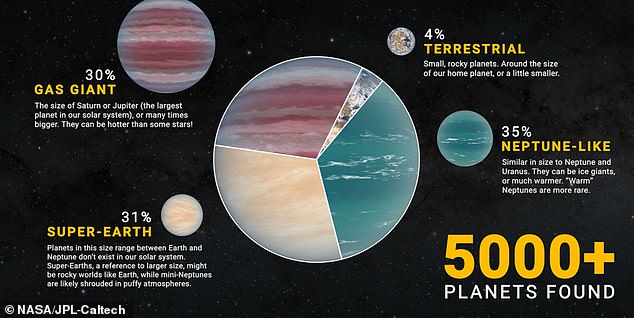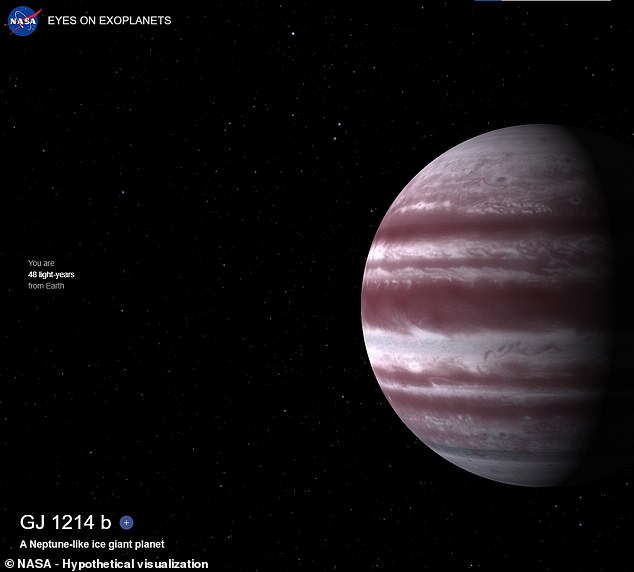Aliens may be stuck on their exoplanet ‘homeworld’ due to ‘physical limitations’, study claims – is this why we haven’t found aliens?
‘Where is everyone?’ It’s the famous alien question, echoing across our silent galactic neighbors after Manhattan Project physicist Enrico Fermi asked it in 1950.
But even a highly advanced alien civilization might be left without the resources or key information needed to escape their homeworld, at least according to a new study from Spain’s Atlántico Medio University.
Some so-called ‘Super Earths’ may be within the habitable zone of their star, but are so massive that their gravity makes interplanetary rocket launches virtually impossible.
These and other ‘Fishbowl Worlds’ are just one of many ideas introduced in the new article, which hopes to help explain Enrico Fermi’s infamous 1950 ‘Fermi Paradox’.
Fermi’s paradox has baffled astronomers for more than six decades. In short, they wonder: In a universe teeming with a whopping 200 billion trillion stars and even more planets, many of which are capable of supporting life, why haven’t Earth’s scientists spotted any aliens?
Even highly advanced alien civilizations could find themselves without the resources (or key information) needed to escape their homeworld, according to a study from Spain’s Atlántico Medio University. Above, Jupiter’s water moon Europa, captured by NASA’s Galileo spacecraft
“The image of a planet whose gravity makes it difficult or impossible to leave reminded me of the metaphor of a fishbowl,” the author of the new study, Professor Elio Quiroga, told DailyMail.com via email.
“I thought it was a powerful analogy,” said Prof. Quiroga, who teaches at Atlántico Medio in Spain.
For one category of his Fishbowl Worlds, Prof. Quiroga calculated a value he called the ‘exoplanet escape factor’ (Fex): a value that compares the escape velocity of a given exoplanet to the speed of 7 miles per second (11.19 kilometers per second) of the Earth. second) escape velocity.
Escape velocity, the speed required for a spacecraft to break free from the gravity of a celestial body – be it a moon, planet or asteroid – varies depending on that body’s mass.
Escaping the potentially habitable exoplanet Proxima Centauri bornfor example, four light-years from Earth is relatively easy: 9.9 miles per second, or a ‘Fex’ of only 0.85 times that of Earth.
But huge, but hypothetically habitable planets like Kepler-131 born746 light-years from Earth, require enormous speeds to break free: 35.8 kilometers per second to leave Kepler-131 b, for example, or a Fex of 3.13 times Earth.


Some so-called ‘Super Earths’ may be within the habitable zone of their star, but are so massive that their gravity makes interplanetary rocket launches virtually impossible, such as Kepler-131 b (left), 746 light-years from Earth. Others, like Proxima Centauri b (right), are easier to shoot from
“Many worlds, especially super-Earths,” Prof. Quiroga told DailyMail.com, “could be rejected due to prohibitive escape velocities.”
But there were also interesting edge cases, such as the habitable world GJ-1214b48 light-years from Earth, which has an escape velocity about 1.5 times that of Earth.
Planets like this, which includes Kepler-103b, may prove more difficult for an advanced race to shoot off, but they may not trap a species on their homeworld.
Prof. Quiroga’s research, published in October last year in the Official Journal of the British Interplanetary SocietyTheorizes that any escape velocity with a Fex greater than 2.2 times that of Earth could lock a civilization to its home planet for good.

The more than 5,000 exoplanets confirmed so far in our Milky Way include all types, including these mysterious “super-Earths” that are larger than our world and may be rocky.
But Prof. Quiroga also pointed to unique cultural factors that could trap a species on its home planet, in one case discussing a more literal “Fishbowl World.”
An advanced civilization on an ocean planet, he speculated, might have mastered long-distance communication through their own evolution, since communication naturally propagates much further in a liquid environment (think sonar) than in the open air.
The dominant species on a watery planet, or a watery moon like Jupiter’s moon Europa, may have enjoyed conversations that naturally travel hundreds of miles.
In those worlds, Prof. Quiroga wrote, “communication between individuals could be feasible without the need for communications equipment,” stifling the drive to innovate advanced communications technologies.

There were also interesting edge cases, such as the habitable world GJ-1214b (above), 48 light-years from Earth, with an escape velocity 1.5 times that of Earth: difficult but possible to leave
“Telecommunications technology may never appear on such a world, even if a fully developed civilization could exist,” Quiroga argued in his article.
“Such a civilization would not be ‘communicative’ and would not be taken into account in the Drake equation,” Quiroga said, the famous calculation formulated to predict the probability of finding intelligent life in the universe.
In other words, an evolutionary trait like innate biological undersea sonar could render them silent and unable to listen to humanity’s SETI radio broadcasts.
But, as Prof. Quiroga told DailyMail.com, his research is no reason for astronomers and planetary scientists not to drastically change policies or research plans just yet.
“The first step is to look for basic life, simple life forms,” he said.
“We are making progress in this direction, but we need more advanced tools (such as the future Vera Rubin telescope) and improved methods for analyzing the weak signals coming from these exoplanets.”
“If we were to discover a world in another galaxy that showed clear and indisputable signs of intelligence,” said Prof. Quiroga, “we could consider whether those beings have made space travel, and whether this is within their capabilities or not.”
What those first, successful signs, which researchers call technosignatures, will turn out to be, he noted, will be partly because of the truly alien possibilities of life beyond our world.
“We can only claim that we know one civilization in the cosmos, and that is ours,” said Prof. Quiroga.
‘That’s why we tend to humanize or anthropomorphize everything; it’s inevitable.’
“However, there is something intriguing to consider,” he added.
“We emerged as a species more or less in the middle of the lifespan of our star, the Sun, which suggests something profound: intelligence takes a significant amount of time to evolve.”
Perhaps, Prof. Quiroga suggested, an answer to Enrico Fermi’s famous paradox is that most alien species take as long to evolve as life here on Earth.
